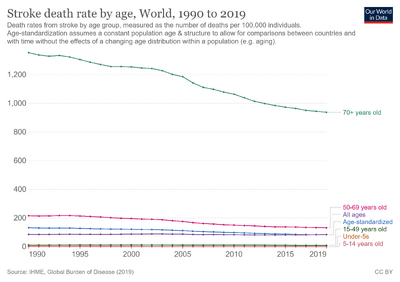Computational modeling of ischemic stroke
Computational modeling of ischemic stroke has been used to understand the biological events during an ischemic stroke, and to identify potential drug targets. These models typically utilize compartment models with ordinary differential equations and partial differential equations.[1][2][3] Models of spreading depressions [1] and ion dynamics [2] have shown that neuronal activity decreases and swelling increases due to an influx of calcium, sodium, and chlorine, and an efflux of potassium and glutamate in neurons during severe and moderate ischemic stroke event.[1][2]
Computational modeling of pH during a stroke also showed that, due to decreases in metabolic activity and increases in lactate and carbon dioxide concentrations in neurons, the pH of the penumbra decreases.[3] These results agree with in vitro and in vivo studies. These computational models can be used in helping to identify proteins or receptors to target by integrating numerous complex mechanisms specific to an ischemic stroke event.[citation needed]
Drug targeting using ADME has been used in identifying drugs to target specific receptors or proteins that have been identified in an ischemic stroke event. For example, stroke can induce an overexpression of NF-κB. This overexpression causes inflammation and neuronal apoptosis.[4] By using ADME, researchers were able to synthesize and identify a drug target that had high binding affinity to NF-κB to prevent its translocation.[5] This technique was also used to identify molecules with high affinity to the choline receptor found in the blood–brain barrier to help in moving therapeutic targets into the brain injury site.[6]
References
- ↑ 1.0 1.1 1.2 Chapuisat G, Dronne MA, Grenier E, Hommel M, Gilquin H, Boissel JP (May 2008). "A global phenomenological model of ischemic stroke with stress on spreading depressions". Progress in Biophysics and Molecular Biology. 97 (1): 4–27. doi:10.1016/j.pbiomolbio.2007.10.004. PMID 18063019.
- ↑ 2.0 2.1 2.2 Dronne MA, Boissel JP, Grenier E (June 2006). "A mathematical model of ion movements in grey matter during a stroke". Journal of Theoretical Biology. 240 (4): 599–615. Bibcode:2006JThBi.240..599D. doi:10.1016/j.jtbi.2005.10.023. PMID 16368113.
- ↑ 3.0 3.1 Orlowski P, Chappell M, Park CS, Grau V, Payne S (June 2011). "Modelling of pH dynamics in brain cells after stroke". Interface Focus. 1 (3): 408–16. doi:10.1098/rsfs.2010.0025. PMC 3262437. PMID 22419985.
- ↑ Qin L, Wu X, Block ML, Liu Y, Breese GR, Hong JS, Knapp DJ, Crews FT (April 2007). "Systemic LPS causes chronic neuroinflammation and progressive neurodegeneration". Glia. 55 (5): 453–62. doi:10.1002/glia.20467. PMC 2871685. PMID 17203472.
- ↑ Shahbazi S, Kaur J, Singh S, Achary KG, Wani S, Jema S, Akhtar J, Sobti RC (January 2018). "Impact of novel N-aryl piperamide NO donors on NF-κB translocation in neuroinflammation: rational drug-designing synthesis and biological evaluation". Innate Immunity. 24 (1): 24–39. doi:10.1177/1753425917740727. PMC 6830765. PMID 29145791.
- ↑ Shityakov S, Förster C (2014-09-02). "In silico predictive model to determine vector-mediated transport properties for the blood–brain barrier choline transporter". Advances and Applications in Bioinformatics and Chemistry. 7: 23–36. doi:10.2147/aabc.s63749. PMC 4159400. PMID 25214795.
